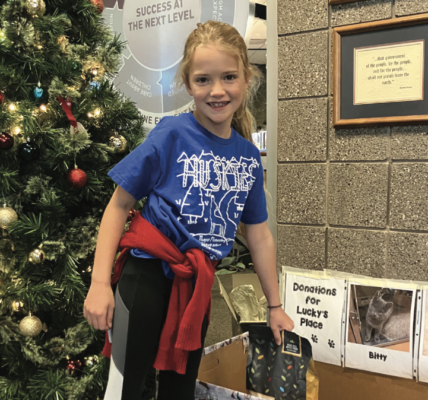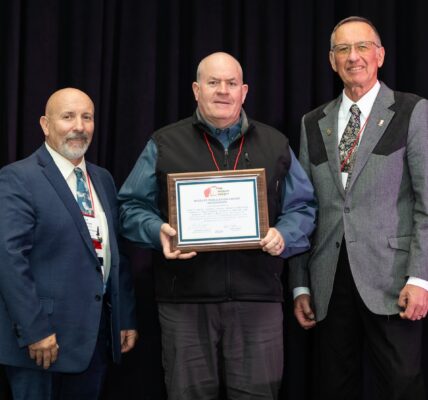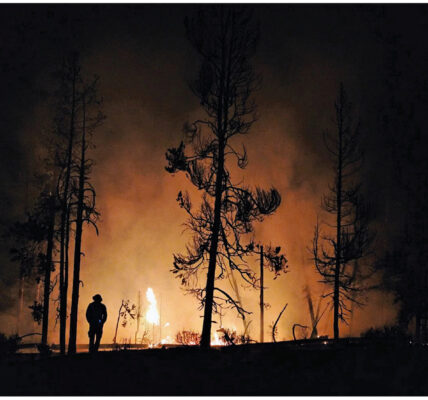
By Jasmine Hall
Wyoming Tribune Eagle
Via- Wyoming News Exchange
CHEYENNE — Just seven months into his second four year term as governor, Mark Gordon sat in his press room with his legs crossed and a stern expression on his face.
He described himself as conservative by nature, a traditional Republican, and a strong believer in free enterprise and capitalism. His approach to leading Wyoming has been influenced by these core values, together with serving as state treasurer for nearly seven years, and facing the elements as a rancher and business owner outside of Buffalo.
It’s been applied to the many responsibilities that fall on his shoulders — a key one being his goal to create a sustainable fiscal path for the state.
“The legacy of being able to preserve those businesses, in good times and bad, has been something that’s really a personal experience of mine,” he told the Wyoming Tribune Eagle earlier this month. “That’s what’s informed my efforts to make sure that we measure the way we spend our funding.”
He referred back to his roots once again in the governor’s supplemental budget message he presented to the Wyoming Legislature late last year. Gordon said Wyoming ranchers know the value of hay, and how a good crop can mean the difference between keeping a herd and having to sell it.
“Bumper crops are not guaranteed,” he wrote.“Significant fluctuations can occur from year to year, depending on management, soil fertility and — most importantly — moisture. Good years mostly coincide with good rainfall and mountain snowpack. Bad years attend drought.
“So, it’s important that ranchers make hay while conditions are right to set aside excess for poorer times in the future.”
He used this connection to explain Wyoming’s economic situation in 2022. Although the state experienced significant rainfall in the form of a revenue boom accredited to the energy and mineral industries, he warned lawmakers of the volatile economic environment they continue to face.
Gordon was wary of President Joe Biden’s administration in Washington, D.C., and said it is “openly adverse to the very core industries that have built our state and made us the best state in the union for taxes.”
He also recognized the nation was experiencing the highest inflation in nearly 40 years, and said “the medicine used to cure it is almost worse than the disease itself.”
Proud accomplishment
Lawmakers heeded the warnings and boasted when the 2023 general session ended that the House of Representatives and Senate had voted to “move forward an unprecedented $1.4 billion in savings and fully fund Wyoming’s K-12 education system.”
Around half of the savings went toward K-12 savings in the Common School Permanent Land Fund and the Common School Reserve Account. The other half went toward general fund savings such as the Legislative Stabilization Reserve Account, also known as the “rainy-day fund.” The latest report shows it stands at close to $1.5 billion, according to the Spring 2023 Fiscal Survey from the National Association of State Budget Officers (NASBO).
“For every $1 that is spent on running our schools and funding local governments, about $3.50 goes to savings in this bill,” said Rep. Bob Nicholas, R-Cheyenne, who is chairman of the House Appropriations Committee, following the session. “This budget bill represents disciplined savings and stewardship, alongside a priority on education and investments in Wyoming’s future generations.”
Gordon was equally proud of both the funds put into savings and Wyoming’s spot as first in the nation in the number of days each state could run on savings alone at 349.6. The data used by The Pew Charitable Trusts was collected from NASBO in 2022, and the rainy-day fund has only grown since then. At the time, only Alaska, North Dakota and New Mexico trailed Wyoming in the 100-day arena.
“I consider it an accomplishment because we are more stable than many of our peers,” the governor said. “Because if you’re going to move to a state with a new business or you’re going to continue a business in the state, you’re going to want to make sure that the business climate, the tax climate and every other aspect of it is pretty secure. Having that kind of security there, I think it’s very attractive and builds the business and economic environment that will help secure the growth that Wyoming will start to see in the years to come.
“This is not new for Wyoming. We’ve done this for a long time.”
Across the nation
It’s also a concept other state legislatures have focused on in recent years. NASBO director of budget process studies Kathryn White analyzed the data and said rainy-day funds reached new heights in fiscal 2022, after already growing sharply in fiscal 2021. She found that “rainy-day funds of this magnitude have never been so widespread across states.”
“States chose to increase their savings,” she said, addressing trends seen in the past three years. “It’s the fluctuations that states were seeing in their budgets and the expectation that a lot of the revenue that they were seeing came in was one-time in nature. Rather than put that revenue toward ongoing commitments that would leave them on the hook for additional spending commitments past that period of time, states were largely opting to put those one-time revenues into one-time uses, and one of those, naturally, is into reserves.
“That’s to guard against future uncertainty.”
White also took a look at what could be in store for fiscal reserves in 2024. Based on NASBO’s analysis of budget proposals and State of the State addresses across the nation, “governors continued to prioritize rainy-day funds as a critical component of sound fiscal management.”
“In some states, particularly those where rainy-day funds have already reached the legal maximum balance, governors propose to maintain these reserves at their current ‘full’ level,” she wrote in her outlook. “Meanwhile, some governors propose to continue growing their rainy-day funds in the coming fiscal year by making additional deposits. Governors are also taking additional steps to strengthen their fiscal resiliency and prepare for the next downturn, including saving money for natural disasters, paying off debt, using surplus funds for capital construction to reduce the need for new borrowing, making supplemental pension payments, and using one-time money for one-time investments.”
Preparing the next budget
Lawmakers and Wyoming officials will be back at the drawing board come next February, and Gordon is already preparing to make recommendations for the 2025-26 biennium budget.
He is expected to release his next two-year budget proposal in November, and the governor’s message hasn’t strayed far recently, as he urged caution in response to the July 2023 revenue update by the Consensus Revenue Estimating Group.The pacing report showed that total revenue collections for the general fund and budget reserve account exceeded the January report by $176.1 million.
A statement from the governor’s office at the end of July echoed continuing concerns with gas prices and volumes steadily declining since reaching record highs a year ago, as well as ongoing threats to legacy mineral industries.
Gordon also noted a key factor in the revenue and budget picture was that “Wyoming was able to recover $584 million of COVID-19-related expenditures from 2020 with American Rescue Plan Act Revenue Replacement funds.”
For the next budget, he said, the Legislature will have to restore $330 million in state general fund dollars to maintain existing government services propped up by the federal funding.
“I am encouraged with the July CREG Pacing Report, which may appear favorable on the surface, but it is important to remember that it is a backward-looking document,” Gordon said. “This examination of recent revenues also shows gathering storm clouds on the horizon that could signal a change in Wyoming’s future revenues. For the upcoming biennium budget, we must recognize the potential of future challenges and be realistic in our assessment of our ongoing financial picture.”
Gordon added in an interview three weeks later that he was comfortable with the progress made and the amount in the LSRA, as long as it was not used as a slush fund. He recognized that the economy is growing, but he explained that developing the budget was complicated, and there was no absolute security.
“I know there’s a notion that there’s so much money, and that over the course of a year a person will spend that money. And that’s not exactly the way our budget works,” he said. “There is a certain amount of money we have in hand. But just as a person does with a job, you anticipate a certain amount of money is going to come in in the month, and then there are these expenses that you have. So you sort of project that over the course of the year. The Consensus Revenue Estimating Group does their best at trying to sort that out near-term.
“But it’s very hard to predict what’s going to happen.”
Legislative defense
Joint Revenue Committee chairs in the Legislature took to the defense of savings, although they also had their own priorities.
Co-Chairman Sen. Bo Biteman, R-Ranchester, told the WTE that he agreed with the conservative approach; however, he was disappointed that a significant portion of the savings was placed into non-permanent accounts.The LSRA is accessible in the case of great need, and that was one of the reasons Gordon considered it a compromise for critics of putting the money away. “Politicians can get their greasy little fingers on it,” Biteman said. “And they will — they always do for some pet projects. So that was disappointing. I hope we can rein it in for the actual budget here coming up in February.”
If there is restraint shown, Biteman said he would be comfortable with more funds being put into the LSRA. He said they must save it for a rainy day, because one comes every five years or so in Wyoming. His ultimate goal is to see revenue excess go toward meaningful property tax relief in the form of a tax cut, though.
“With a boom-bust cycle in the oil and gas industry, the current economy is kind of wobbly right now. Or we could go into a deep recession at any time,” he said. “So, those issues need to be in the forefront of our minds when we’re socking money away, because we’re going to need that money sooner than later.”
He also pushed back against those who have argued saving for tomorrow can hurt the residents of today, whether that be in a lack of funding for government services or salary increases for state employees.
“I don’t think anybody’s hurting right now in Wyoming,” he said. “I think everything’s funded. The Appropriations Committee last session basically restored all the previous cuts that went on during the last austerity measure that Gov. Gordon had to do when he first came into office when we were broke.Those came back, and then we gave 8% raises to state employees. We gave the (K-12 schools) the cost-of-living adjustment. We’re fully funding education. So I don’t think anybody’s hurting at the moment.
“My fear is we’re not preparing for the imminent recession that’s probably going to be coming our way, and then we’re going to be right back to where we were three or four years ago, when we were looking for pennies under the couch cushion and cutting everything we could possibly cut.”
Gordon said it depends on the timeframe.
What’s at risk
“If everyone had all the money right now, I’m sure we would have a wonderful time,” he said. “But hangovers are tough, and my concern really comes to how do we weigh today’s needs with tomorrow’s potential wants — and balance that.”
Biteman’s colleague on the Joint Revenue Committee placed just as heavy an emphasis on the volatility of the economy, just as the governor, lawmakers and officials from the Treasurer’s Office have reiterated in the name of fiscal conservatism.
“We have the largest reserve to fund government days. Absolutely,” said Revenue Committee co-Chairman Steve Harshman, R-Casper. “But we also have the most volatile revenue sources in the country — us, Alaska, North Dakota. So, you know, the ups and downs also are tougher than most. Most states’ income tax, property tax, sales tax, those all kind of generally increase 3% to 4% a year. Ours is not like that. It’s usually the opposite of the national economy.” Harshman has seen the impacts of not having enough money in savings. He said he remembered making tough cuts in the past decade that touched nursing homes, residents with disabilities and salaries for state employees, and they’ve tried to restore them with the increased revenue. He said he wants to make sure those needs are met while still providing a reserve to lean on.
Gordon weighed in on the kinds of cuts that might be required, as well, and he asked, “How do you choose what to sacrifice?”The biggest portions of the budget go toward education, the Department of Health, Department of Family Services and Department of Corrections. He said if you want meaningful reductions, then that is what is at risk.
He also said no one is happy even when small changes have to be made. The governor pointed to losing a third of the state’s revenue during COVID-19 and the decision to close rest areas outside of towns.
“We did that within five miles of town, because we thought people could go on to the town. We also said to the towns, if you want to keep the rest areas going, you can take them over, but we can’t afford to keep them,” he said. “We kept the ones that were much more remote, so that there was still the ability to visit them. But more people blew up over that than almost anything else that we did.
“Because how dare you close my rest area, even if you could just go into town. In fact, we had one community that said, ‘Well, we just don’t want those people here. So, you need to keep that rest area open.’” He said when people understand what is at risk, then they may understand the need to save.
Saving to invest
But it’s not just about packing state dollars away into the “rainy-day fund” or other trusts, it’s how the dollars work for Wyomingites.
During Gordon’s time as treasurer, he is credited with transforming and modernizing the management of the state’s financial portfolio. This legacy has carried on under State Treasurer Curt Meier, whose office was investing more than $26 billion as of June 30, and investment income is currently the second-largest source of revenue coming into the general fund.
“If you look at the three-legged stool — we have mineral income, we have sales and use tax and our investment income,” Gordon said. “And as mineral income has declined over the years, the importance of investment income is extremely important.”
There is a careful process for investing the state dollars, which is different from simply capitalizing on the returns produced by the Permanent Mineral Trust Fund or even the LSRA. Patrick Fleming, the state’s chief investment officer, said asset allocation spans a yearly review, where they consider return assumptions that are based on a one- to two-decade outlook, along with feedback from the investment committee of seven highly talented individuals that have vast experience in the financial market.
“We look at the long-term view, because this is for intergenerational equity for the state of Wyoming,” Fleming said.
Even after all of that, the State Loan and Investment Board, made up of the top five state elected officials, has to give its stamp of approval.
Fleming said he hopes the governor and the Legislature will continue to take a savings approach for the same reasons, and applauded Treasurer Meier for looking into creating a generational fund. It would require a constitutional amendment, but millions would likely be taken out of the LSRA or other mineral royalties to start it, and he recommends the largest initial investment possible.
He said it would not be touched in any way for a few decades, and could provide historical returns.
This is seen as an extra assurance for stability in a state with the third-highest revenue volatility of the nation.
“Can you imagine a corporate entity having a runway of two years?” he asked. “Of saying, ‘OK, this is your income, and this is how much we’re going to have. But in two years, that could change.’
“So you go out and you hire 100 people, and in two years, you have to fire 50.”
More than conservation
While this could be argued as just the desires of the Republican Party or the Treasurer’s Office, one Democrat in the Wyoming Legislature sees no other choice.
Sen. Mike Gierau, D-Jackson, sits on both the Senate Appropriations Committee and the Select Committee on Capital Financing and Investments, as well as myriad other governing bodies. He believes the Legislature should be redoing the state’s tax structure, which is built around the mineral extraction industry, but he doesn’t believe it is possible in the current political environment.
Even with efforts to diversify the economy, Gierau told the WTE that there is no system to tax them in a way that will benefit constituents. He said when new businesses do come to the state, they end up burdening it. He added that the people who come to work at those new businesses often have families who need government services, and there is no way to pay for them without the third leg of the stool — investment income.
He said he wants there to be additional revenue coming into the system to provide the services the public needs and wants, and the way to make that possible is by placing as much money as possible into savings and investment accounts in their long-term total return investment strategy. Gierau is also pushing against policies he believes threaten this form of income, such as environmental and social governance policy bans.
These perspectives come from a different place than the rest of the Republican-majority Legislature and executives leading the state, but he came to the same conclusion: Saving the dollars will protect the people of Wyoming when the boom-and-bust cycle inevitably runs its course.
Making hay appears to be their answer.
“By all accounts, the winter of 1886-87 was a complete bust,” Gordon wrote. “The snow caught livestock producers, accustomed to plentiful winter grass, completely unprepared. Thousands of cattle and sheep died, and the ranchers learned the value of laying in hay for winter feed.
“Truth be told, grazing pressure on the rangelands of Wyoming had been increasing for a few years, putting herds at greater risk. Coming out of that winter, many operations went bust, and tensions soared between large and small outfits, cattle and sheep, and all because, in good times, folks had forgotten that ‘plenty’ could become ‘want’ in the blink of an eye.”





